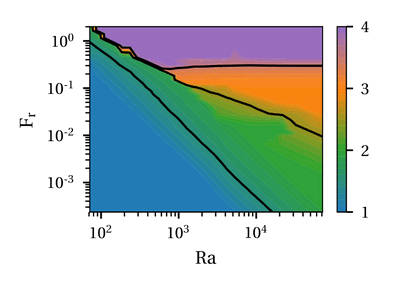Y.M. Dijkstra1*, H.M. Schuttelaars1
1 TU Delft, Delft Institute of Applied Mathematics
Introduction
The salinity structure in estuaries is classically described in terms of the salinity structure as well-mixed, partially mixed, or salt wedge. The existing knowledge about the processes that result in such salinity structures comes from highly idealised models that are restricted to either well-mixed or partially mixed cases or salt wedge estuaries. Hence, there is still little knowledge of the differences in dominant processes driving these different types of salinity structures and the estuarine parameters at which a transition from one such structure to another is found.
Methods
As an important step toward a unified description of processes driving well-mixed, partially mixed, and salt wedge estuaries, we developed a fully nonlinear subtidal width-averaged model that is applicable to all these salinity structures. The model was run for a straight uniform rectangular channel for a large range of model parameter values representing the entire estuarine parameter space.
Results
We identified four salinity regimes, resulting from different balances of dominant processes: (1) a dispersion dominated regime; (2) the Chatwin regime, dominated by gravitational circulation; (3) the Chatwin regime with salinity front, similar to regime 2 but with a distinctive salinity front dominated by momentum advection; and (4) a fully momentum advection-driven salt wedge regime. It is shown that each regime is uniquely determined by two dimensionless parameters: an estuarine Froude and Rayleigh number, representing fresh water discharge and tidal mixing, respectively. This results in a classification of the regimes in terms of these two parameters (Figure 1).
Furthermore, analytical expressions to approximate the salt intrusion length in each regime are developed. These expressions are used to illustrate that the salt intrusion length in different regimes responds in a highly different manner to changes in depth of fresh-water discharge. Finally, we show that there are only very weak relations between the process-based regime of an estuary and the salt intrusion length and top-bottom stratification.

Figure 1 The four regimes (indicated by colours) dominated by transport due to (1) dispersion, (2) gravitational circulation, (3) momentum advection at a distinctive salinity front, (4) advection in a salt wedge. The regimes are plotted in the parameter space of the fresh water Froude number (Fr; indicating discharge) and the estuarine Rayleigh number (Ra; indicating mixing).
I. Surname1*, F.N. Another-Surname2 , Y. Next-Surname2
1 University Name, Country; 2 Organization Name, Country
* Corresponding author: mail.name@organization.org


